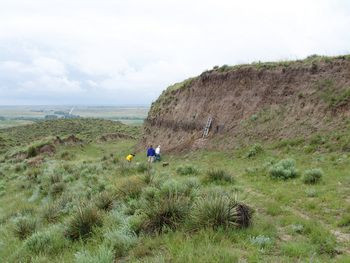Ancient Soils Are ‘Reservoirs’ Of Carbon And Could Contribute To Climate Change

There is far more carbon stored in the Earth’s soil than previously thought, a new study has shown, and scientists fear disturbing it could unleash vast amounts of it into the atmosphere.
According to new research, published Sunday in the journal Nature Geoscience, ancient soil that was buried thousands of years ago has been found to be rich in organic carbon. The soil is up to six-and-a-half meters, or 21 feet, below the present-day surface and could be exposed through erosion, agriculture, mining, deforestation and other human activities.
“There is a lot of carbon at depths where nobody is measuring,” Erika Marin-Spiotta, a University of Wisconsin-Madison assistant professor of geography and the lead author of the new study, said in a statement. “It was assumed that there was little carbon in deeper soils. Most studies are done in only the top 30 centimeters. Our study is showing that we are potentially grossly underestimating carbon in soils.”
Scientists have long known that, like forests and oceans, Earth’s soil sequesters carbon and is another stop on the environmental carbon cycle. What is unclear is exactly how much carbon is stored in the Earth’s surface; some estimates put the amount of carbon in the upper 100 cm of soil at about 2,200 gigatons.
Marin-Spiotta and her team studied a patch of soil in the Great Plains of southwestern Nebraska known as the Brady soil, which formed between 15,000 and 13,500 years ago. It was buried by a vast accumulation of windborne dust, called loess, beginning in about 8,000 B.C. during the last glacial retreat.
The region where the Brady soil formed wasn’t covered in glaciers like much of North America at the time, but rapid climate change shifted its vegetation and led to a series of wildfires. As large deposits of loess blanketed the area, it led to more carbon being sequestered in the soil.
“The world was getting warmer during the time the Brady soil formed,” Joseph Mason, a UW-Madison geography professor and co-author of the study, said in a statement. “Warm-season prairie grasses were increasing and their expansion on the landscape was almost certainly related to rising temperatures.”
Researchers used both spectroscopic and isotopic techniques to analyze the content of the exposed Brady soil. They found high levels of black carbon, an indication of extensive biomass burning.
Researchers say the kind of carbon sequestration witnessed in the Great Plains occurs worldwide, and that as humans continue to alter landscapes, sequestered carbon could be reintroduced into the environment.
© Copyright IBTimes 2024. All rights reserved.






















